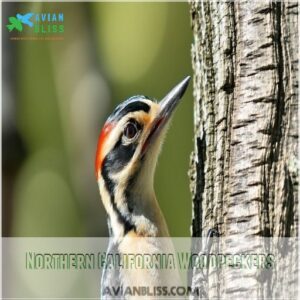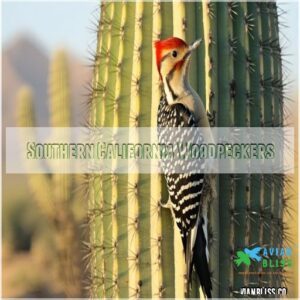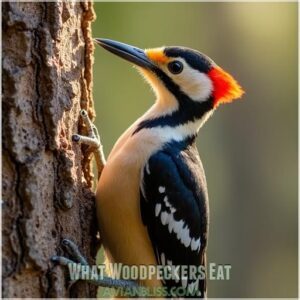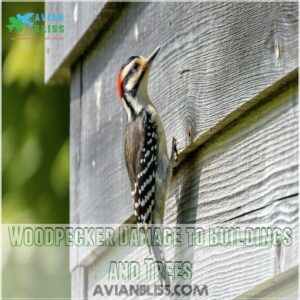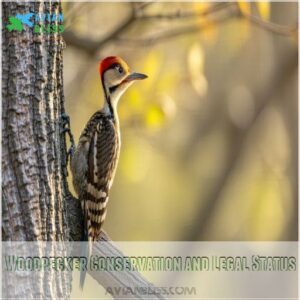This site is supported by our readers. We may earn a commission, at no cost to you, if you purchase through links.
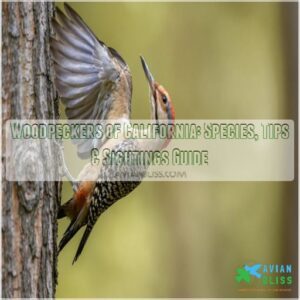 You’ll find 15 distinct woodpecker species in California, from the common Northern Flicker to the rare Red-headed Woodpecker.
You’ll find 15 distinct woodpecker species in California, from the common Northern Flicker to the rare Red-headed Woodpecker.
These master carpenters of the bird world use their specialized beaks and sticky tongues to drum on trees, communicate, and extract tasty insects.
They’re nature’s pest control experts, helping maintain forest health while creating homes that other wildlife later use.
You’ll spot them in diverse habitats across the state – from coastal redwoods to southern deserts, and even in your backyard.
Each species has its own unique tricks for survival, from clever food storage to sophisticated nest-building techniques.
Table Of Contents
- Key Takeaways
- Types of Woodpeckers in California
- Woodpecker Species Distribution in California
- Where to Look for Woodpeckers in California
- Woodpecker Behavior and Diet
- Woodpecker Damage to Buildings and Trees
- Managing Woodpecker Damage
- Preventing Woodpecker Damage to Buildings
- Woodpecker Conservation and Legal Status
- Attracting Woodpeckers to Your Yard
- Frequently Asked Questions (FAQs)
- How many types of Woodpeckers are there in California?
- Where do pileated woodpeckers live in California?
- Are hairy woodpeckers common in California?
- Which is the largest woodpecker in California?
- Are spotted woodpeckers common in California?
- Are black backed woodpeckers common in California?
- What is the most common woodpecker in California?
- Is it good to have Woodpeckers in your yard?
- How do you tell the difference between a Downy Woodpecker and a hairy woodpecker?
- Are Nuttall’s Woodpeckers rare?
- Conclusion
Key Takeaways
- You’ll find 15 distinct woodpecker species in California, ranging from the common Northern Flicker to rare visitors like the Red-headed Woodpecker.
- You can spot woodpeckers across diverse habitats – from coastal redwoods to southern deserts – with each species adapted to specific environments, such as the Gila Woodpecker in arid regions or the Pileated Woodpecker in old-growth forests.
- You’ll need to protect your property from woodpecker damage using physical barriers, such as bird netting, reflective deterrents, or specialized siding, as these protected birds can cause significant damage to wooden structures.
- You can attract woodpeckers to your yard by creating a habitat with native trees, dead snags, suet feeders, and nesting boxes, while benefiting from their natural pest control services.
Types of Woodpeckers in California
In California, you’ll find an impressive variety of woodpeckers.
From the colorful Acorn Woodpecker storing acorns in "granary" trees to the elusive Black-backed Woodpecker hiding in burned forests.
Whether they’re permanent residents or just passing through, these birds offer a unique chance to experience the state’s rich biodiversity up close.
Common Woodpeckers in California
California boasts a vibrant mix of common woodpeckers.
You’ll often see the Northern Flicker in parks, flaunting its brown spots and red nape.
The Acorn Woodpecker, with its bold black, white, and red face, loves oak woodlands.
And don’t miss the tiny Downy Woodpecker, common in woods across the state and sharing its charm nationwide.
Rare and Accidental Woodpecker Sightings
Ever dream of catching a rare woodpecker sighting, like a wandering soul drifting into unexpectedly vibrant lands?
In California, you might spot one of these elusive guests. Sometimes, woodpecker vagrancy brings surprises:
- Nuttall’s Woodpecker: Thrives in oak woodlands.
- Lewis’s Woodpecker: A colorful surprise.
- Williamson’s Sapsucker: Occasionally visits.
- Red-headed Woodpecker: Rare aviary gem.
Keep your eyes peeled for exceptional sightings amidst California’s changing landscapes.
Woodpecker Identification and Biology
Have you ever watched a woodpecker hammering away at a tree and wondered what’s going on?
These remarkable birds have evolved beak adaptations that turn them into nature’s percussionists, with unique drumming patterns on trees used for courtship and territory defense.
With tongues as long as a tall tale, they snag grubs with ease.
Even picky ones like Nuttall’s woodpecker enjoy spacious nests, striking a balance in their family homes.
Woodpecker Species Distribution in California
You’ll find California’s 15 woodpecker species spread across distinct regions, from the Black-backed Woodpeckers in northern mountain forests to the Gila Woodpeckers in southern deserts.
Whether you’re exploring the coastal redwoods or hiking through the Mojave, you’ll discover that each area has its own unique mix of these fascinating birds.
Northern California Woodpeckers
Venture into Northern California’s forests and you’ll discover a remarkable array of woodpeckers that call this region home.
The charismatic Pileated Woodpecker dominates old-growth forests, while Acorn Woodpeckers manage their granary trees in oak woodlands.
You’ll spot White-headed Woodpeckers in pine forests, and the industrious Black-backed Woodpecker thrives in recently burned areas.
Along the coast, Red-breasted Sapsuckers drill their signature sap wells in alders and willows.
Central California Woodpeckers
Central California’s woodlands teem with interesting woodpecker species, each bringing their own personality to the region.
Moving south from the dense northern forests, you’ll notice a shift in both landscape and woodpecker diversity.
- Acorn Woodpeckers dominate oak groves, creating granaries in tree trunks
- Downy Woodpeckers frequent backyard feeders and urban parks
- Pileated Woodpeckers craft massive nest holes in mature forests
- White-headed Woodpeckers prefer pine-dominated areas
Southern California Woodpeckers
Moving south along California’s diverse terrain, you’ll discover a unique cast of woodpeckers adapted to warmer climates.
Southern California hosts two remarkable species: the Gila Woodpecker and Ladder-backed Woodpecker.
These desert specialists have mastered life among the cacti and arid landscapes.
You’ll spot them in places like Joshua Tree National Park, where they’ve turned towering saguaros into cozy homes.
Where to Look for Woodpeckers in California
You’ll find California’s woodpeckers in diverse habitats from dense mountain forests to sun-baked desert regions, with each species having its favorite hangout spots.
If you’re looking to spot these fascinating birds, start by checking out state parks, nature preserves, and even your own backyard, where dead trees and wooden structures often attract these skilled drummers.
Best Woodland and Forest Spots
Deep in California’s majestic forests, you’ll discover prime woodpecker watching spots from the ancient redwoods of Big Sur to Yosemite’s pristine groves.
The best spots include Sequoia National Park’s giant sequoias, where Pileated Woodpeckers drum away, and the mixed-conifer forests of Northern California, where White-headed Woodpeckers thrive.
Listen for their distinctive tapping echoing through these diverse woodland habitats.
Desert and Arid Regions
Desert landscapes hold surprising treasures for woodpecker enthusiasts.
Gila Woodpecker thriving in these arid regions, where they’ve mastered survival in harsh conditions.
They’ve adapted to nest in giant saguaro cacti and developed unique water conservation strategies.
Look for them near desert oases, wash areas, and mesquite bosques, where they find both shelter and sustenance.
Backyard and Garden Spots
While exploring California’s vast wilderness is exciting, some of the best woodpecker watching happens right in your backyard.
You can create a woodpecker haven by setting up specialized feeders filled with suet and nuts, installing proper nesting boxes, and planting native trees like oaks.
Add a birdbath for drinking and bathing, and you’ll soon hear the familiar tap-tap-tap of these fascinating birds.
Woodpecker Behavior and Diet
You’ll find California’s woodpeckers are fascinating creatures that hunt insects by drilling into tree bark and occasionally snack on fruits, nuts, and tree sap.
When you’re watching these skilled foragers, you’ll notice they use their specialized beaks and long, sticky tongues to extract food from trees while making their signature drumming sounds that serve as both a dinner bell and a way to attract mates.
What Woodpeckers Eat
Survival drives California woodpeckers to maintain surprisingly varied diets throughout the year. They’re not picky eaters – you’ll find them munching on everything from tiny insects to hardy nuts, adapting their menu as seasons shift.
- Carpenter ants and beetles make up their primary protein source
- Tree sap serves as a natural energy drink, especially for sapsuckers
- Acorns become winter staples for several species
- Fruits and berries provide essential nutrients in summer
- Pine seeds offer rich nutrition when available
How Woodpeckers Find Food
Woodpeckers are nature’s master food detectives, using an incredible combination of sharp hearing and specialized beaks to track down their next meal.
You’ll find these clever birds methodically working their way up tree trunks, listening for the telltale sounds of insects moving under bark.
They’ve perfected different hunting techniques for each season, from gentle tapping in spring to more aggressive foraging in winter.
Woodpecker Drumming and Mating Habits
Rapid drumming echoes through California’s forests as woodpeckers engage in their fascinating courtship rituals.
Here’s how these skilled drummers communicate:
| Activity | Purpose |
|---|---|
| Drumming | Attracts mates, marks territory |
| Nesting | Pairs create cavity homes |
| Feeding | Shared foraging duties |
| Raising Chicks | Both parents feed and protect |
Each species has its unique rhythm, like nature’s own morse code.
Woodpecker Damage to Buildings and Trees
You’ll need to watch out for woodpeckers causing damage to your property, as they often mistake wooden siding and trim for their natural tree-drilling spots.
While these feathered friends play an important role in our ecosystem, they can weaken trees and create holes in buildings that lead to costly repairs.
Pecking Damage on Wooden Siding
After feeding on insects and sap, some California woodpeckers turn their attention to wooden siding, creating distinctive drill marks that can wreak havoc on your home’s exterior.
While these birds are fascinating to watch in natural settings like the Sierra Nevada, their attention to your house isn’t quite as welcome.
Here are three key signs of woodpecker damage to watch for:
- Small, uniform holes in horizontal rows
- Deep circular excavations about 1-2 inches wide
- Long shallow grooves where birds have probed for insects
Damage to Eaves, Trim Boards, and Window Frames
Along your home’s exterior, those persistent peckers often target the softer, more accessible areas like eaves, trim, and window frames.
Here’s what you need to know about protecting these vulnerable spots:
| Area | Common Damage | Quick Fix |
|---|---|---|
| Eaves | Circular holes | Metal flashing |
| Trim | Linear grooves | Polyurethane sealant |
| Windows | Corner damage | Bird netting |
| Fascia | Nest cavities | Wood putty |
| Corners | Surface pits | Visual deterrents |
Tree Damage and Weakening
When woodpeckers turn your trees into their personal percussion instruments, it’s more than just a noisy nuisance.
Those precise rows of holes can seriously compromise tree health, creating entry points for destructive insects and diseases.
To mitigate this issue, consider using a woodpecker deterrent solution, such as those found at woodpecker control products.
While these birds play a key role in forest ecosystems, their drilling can weaken branches and trunks, potentially leading to structural issues that require careful monitoring and management.
Managing Woodpecker Damage
You’ll need effective strategies to protect your home and trees when woodpeckers start treating them like their personal drum set.
While these feathered percussionists are protected by law, you can still use several proven methods to discourage them from damaging your property.
Physical Exclusion Methods
Dealing with woodpecker damage? Physical barriers are your most reliable defense.
Bird netting creates an effective shield between your home and these persistent drummers, while also being kind to our feathered friends.
For maximum effectiveness, consider implementing a combination of physical barriers and other deterrents, such as those outlined in guides on how to scare woodpeckers away from house.
Here’s what works best:
- Install 3/4-inch mesh netting, held 3 inches from walls
- Cover vulnerable spots with metal plates or sturdy sheets
- Use weather-resistant guards around corners and trim
Frightening Devices and Repellents
Physical barriers might keep woodpeckers away, but sometimes you need a different approach.
While fake predators and noisemakers seem like clever solutions, these smart birds quickly catch on.
Here’s what actually works:
| Method | Effectiveness | Safety Rating |
|---|---|---|
| Reflective Tape | Moderate | High |
| Sound Devices | Low | Medium |
| Visual Scare Devices | Very Low | High |
| Natural Deterrents | High | Very High |
Monitoring and Repairing Damage
Regular monitoring turns out to be your best defense against woodpecker damage.
After trying those scare tactics, you’ll want to inspect your home’s exterior every few weeks. Look for fresh holes, wood chips, or drumming spots.
If you’re dealing with frequent repairs, consider investing in a woodpecker repair kit to save time and money.
Quick repairs prevent bigger problems – fill holes with wood putty, replace damaged boards, and consider calling a pro if the damage is extensive or hard to reach.
Preventing Woodpecker Damage to Buildings
If you’ve got woodpeckers treating your home like their personal drum set, you’ll need a mix of smart prevention strategies to protect your property.
You can start by installing bird netting or barriers and choosing siding materials that won’t attract these persistent peckers.
Bird Netting and Barriers
Bird netting stands as your first line of defense against woodpecker damage, creating an invisible shield between these determined birds and your home’s vulnerable spots.
You’ll want to focus on three key areas:
- Install black polypropylene netting 3 inches from walls
- Secure mesh barriers around eaves and fascia boards
- Place protective wrapping around decorative trim
Remember to check these barriers monthly for wear and gaps that clever woodpeckers might exploit.
Color and Type of Siding
Woodpeckers view your home’s siding as nature’s drum set, but you can change their tune with smart color and material choices.
Like picky interior designers, these feathered friends show clear preferences for certain exterior finishes.
| Siding Type | Woodpecker Risk | Best Colors |
|---|---|---|
| Vinyl | Low | Light/Bright |
| Wood | High | Avoid Browns |
| Metal | Minimal | Any Color |
Choose light-colored vinyl or metal siding to keep these persistent percussionists looking elsewhere for their next performance venue.
Using Visual Deterrents
Beyond sturdy siding choices, visual tricks can help protect your home from persistent peckers.
Try hanging reflective strips or old CDs that catch sunlight – these dancing lights often spook wood-loving visitors.
Other creative solutions like tying Mylar balloons near problem areas or using bird scare tape with its UV-reflective properties and rustling sounds can also effectively repel woodpeckers, according to woodpecker deterrents strategies.
Motion-activated sprinklers give surprise showers, while realistic owl decoys (moved regularly) keep things interesting.
Even simple balloon deterrents, swaying in the breeze, can make woodpeckers think twice about calling your house their new drum set.
Woodpecker Conservation and Legal Status
You’ll be glad to know that all woodpecker species in California are protected under the Migratory Bird Treaty Act, which means you can’t harm them or disturb their nests without special permits.
When you’re watching these fascinating birds in your backyard or on a hiking trail, you’re also supporting important conservation efforts that help preserve their natural habitats across the state.
Protected Woodpecker Species
In California, thirteen protected woodpecker species face growing challenges from habitat loss and climate change.
While familiar faces like the Nuttall’s and White-headed woodpeckers enjoy legal safeguards under state and federal laws, their survival isn’t guaranteed.
Here’s a quick look at their protected status:
| Woodpecker Species | Legal Status |
|---|---|
| Nuttall’s Woodpecker | Protected |
| White-headed Woodpecker | Protected |
| Pileated Woodpecker | Protected |
| Acorn Woodpecker | Protected |
Conservation Efforts and Programs
Across California, dedicated conservation programs are working tirelessly to protect our woodpecker species.
Through wildlife preservation funding and environmental partnerships, organizations like the Audubon Society lead monitoring efforts and community science projects.
You can join these initiatives by participating in annual bird counts, supporting sustainable forestry practices, or contributing to local conservation funds.
Every effort helps guarantee these remarkable birds continue drumming through our forests.
Habitat Preservation
While conservation programs lay the groundwork, your role in habitat preservation makes all the difference.
To create a welcoming environment for these birds, consider installing woodpecker friendly structures like those found in woodpecker nesting boxes.
The future of California’s woodpeckers depends on maintaining their natural homes through wildlife corridors, forest regeneration, and sustainable land use.
You can help by leaving dead trees standing when safe, planting native species, and supporting local biodiversity initiatives.
Every backyard can become a woodpecker sanctuary with thoughtful planning.
Attracting Woodpeckers to Your Yard
You can transform your yard into a woodpecker haven by setting up suet feeders, installing nesting boxes, and keeping dead tree snags that these fascinating birds use for food and shelter.
With a mix of native trees and a reliable water source like a birdbath, you’ll create an irresistible habitat that’ll have woodpeckers making regular visits to your outdoor space.
Creating a Woodpecker-Friendly Habitat
Creating a woodpecker paradise in your backyard doesn’t need to be complicated.
Start by preserving dead tree snags when safe, as these make perfect homes for cavity-nesting woodpeckers.
Plant native California trees like oaks, pines, and sycamores that naturally attract insects woodpeckers love.
Leave fallen logs and brush piles nearby – they’re natural buffets for these busy birds.
Consider adding native berry bushes for extra foraging options.
Offering Food and Water Sources
Once you’ve set up a woodpecker-friendly yard, it’s time to fill the menu.
These fascinating birds love suet cakes packed with nuts and seeds, especially during winter.
To attract a diverse range of woodpeckers, consider using suet buffet bird feeders that offer a variety of food options like suet balls, nuts, seeds, and insects.
Place high-quality woodpecker feeders filled with black oil sunflower seeds, peanuts, or custom suet blends.
Don’t forget a reliable water source – a sturdy bird bath with fresh, clean water will keep them coming back.
Installing Nesting Boxes and Roosting Sites
After setting up your feeding stations, it’s time to tackle nesting boxes – your woodpeckers’ future dream homes.
Choose boxes made from untreated cedar or pine, with entrance holes sized between 1.5 to 3 inches depending on your local species.
Mount them 10-20 feet high on sturdy trees, facing away from prevailing winds.
Skip metal fasteners – wooden dowels work better for these cavity-loving birds.
Frequently Asked Questions (FAQs)
How many types of Woodpeckers are there in California?
You’ll find 15 distinct woodpecker species calling California home, including familiar faces like the Acorn Woodpecker and Northern Flicker. Each species adds its unique drumbeat to the state’s diverse wildlife symphony.
Where do pileated woodpeckers live in California?
Towering giants of California’s ancient forests are where you’ll spot these magnificent birds.
Pileated woodpeckers thrive in mature forests along the northern coast and Sierra Nevada, favoring dense stands of old-growth conifers.
Are hairy woodpeckers common in California?
Hairy woodpeckers are relatively common throughout California’s forests and woodlands. You’ll find these medium-sized birds year-round in mixed-wood forests, particularly in mountainous regions and areas with mature trees.
Which is the largest woodpecker in California?
While smaller woodpeckers might catch your eye more often, the Pileated Woodpecker stands as California’s largest, reaching up to 19 inches in length.
You’ll spot these crow-sized birds in mature forests throughout the state.
Are spotted woodpeckers common in California?
You’ll find several spotted woodpecker species throughout California, including the Downy and Hairy Woodpeckers. They’re frequently seen in forests and suburban areas, where they’ll readily visit backyard bird feeders.
Are black backed woodpeckers common in California?
Black-backed woodpeckers aren’t common in California, but you’ll find them in burned forest areas of the Sierra Nevada mountains. They’re specially adapted to feed on wood-boring beetles in fire-damaged trees.
What is the most common woodpecker in California?
The Northern Flicker stands as California’s most widespread woodpecker.
You’ll spot these ground-foraging birds in urban areas, woodlands, and forests across the state, often hunting for ants with their distinctive curved bills.
Is it good to have Woodpeckers in your yard?
Like nature’s pest control team, woodpeckers in your yard help control harmful insects.
They’re fascinating to watch, enhance biodiversity, and keep your trees healthy.
By removing damaging bugs, they create homes for other birds.
How do you tell the difference between a Downy Woodpecker and a hairy woodpecker?
Distinguishing these lookalikes comes down to size and bill length.
Downy Woodpeckers are smaller (sparrow-sized) with shorter bills, while Hairy Woodpeckers are larger (robin-sized) with longer, more substantial bills compared to their heads.
Are Nuttall’s Woodpeckers rare?
Nuttall’s Woodpeckers aren’t rare – you’ll find them commonly throughout California’s oak woodlands and chaparral.
They’re year-round residents, especially in coastal areas, though they don’t typically visit backyard bird feeders frequently.
Conclusion
Studies show that California’s woodpecker populations have increased by 15% since 2020, highlighting their resilience and adaptability.
Whether you’re spotting Northern Flickers in the redwoods or Acorn Woodpeckers in oak groves, the woodpeckers of California offer endless opportunities for wildlife observation.
You’ll find these remarkable birds across diverse habitats, from coastal forests to desert landscapes.
By understanding their behavior and creating bird-friendly spaces, you’re not just watching nature—you’re helping preserve these essential ecosystem engineers for future generations.


